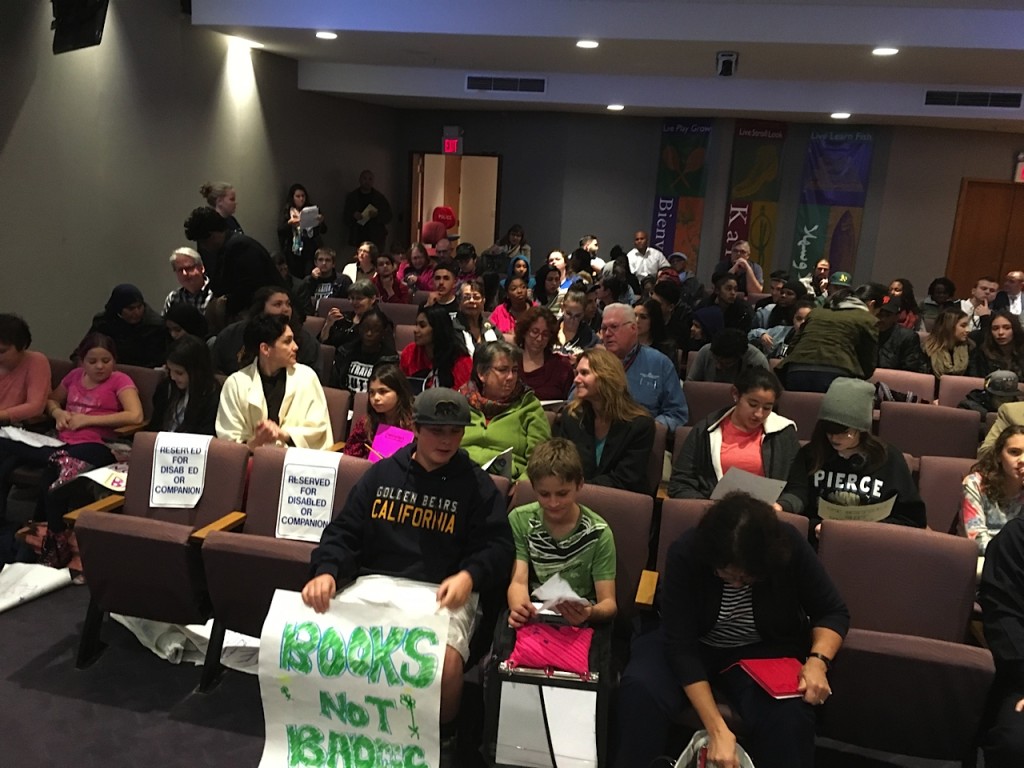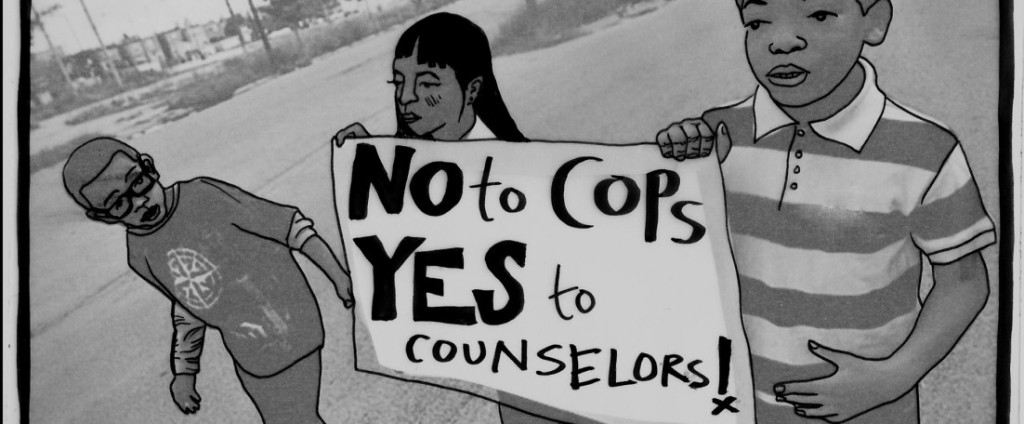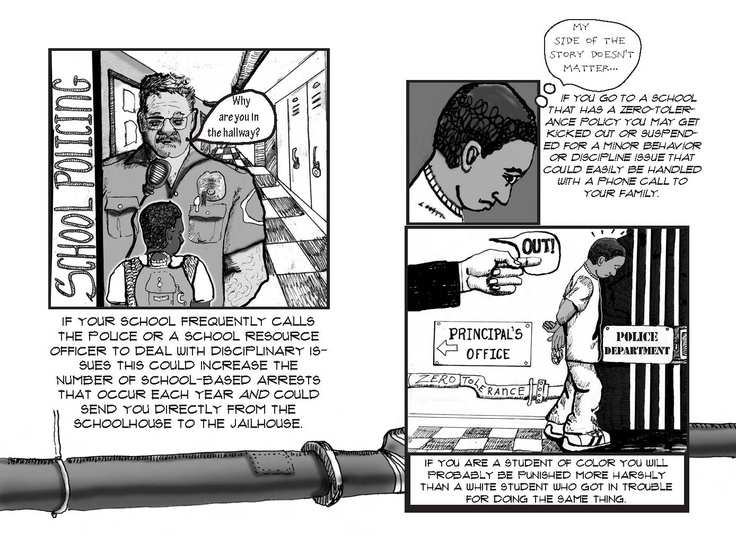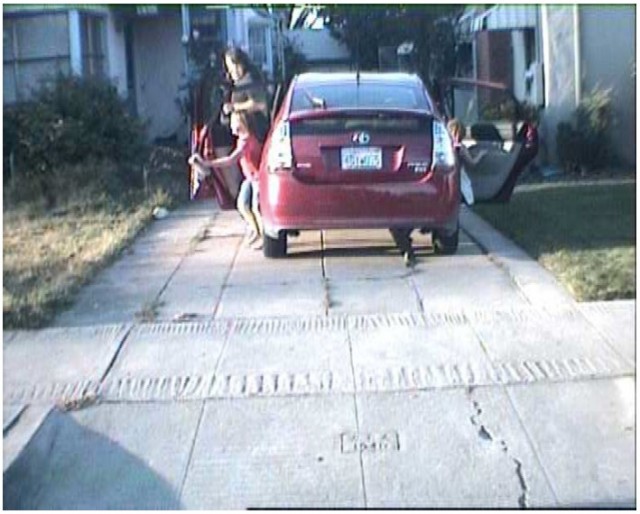
Drawing by 10 yo Camila of the curriculum committee meeting. Camila was one of two kids not allowed to tell her views on the program.
A couple of weeks ago, I got a lesson on how the school-to-prison pipeline works, explained by the two School Resource Officers (SROs) that are assigned to San Leandro schools. Just this week, I had another big lesson on how institutionalized racism and even sexism by School Board members combine with the surveillance state not only to make sure the school to prison pipeline runs as smoothly as possible, but to disempower anyone that would question it.
Sounds boring so far? Bear with me, we’ll get to the drama quickly enough.
Last Tuesday night the San Leandro School Board curriculum committee met to hear a presentation by San Leandro Police Department (SLPD) officers on a proposed program that will put police officers on elementary school campuses to teach a “gang prevention” curriculum during class hours, thus taking away time from actual academic teaching. If approved, police officers will be treated as faculty members, have complete run of campus, be allowed to stop and interrogate children about any matters and attend parent and faculty meetings. While on campus, police officers can overhear private conversations and gather evidence that they can use against the parents and family members of school children. The police officers, moreover, are not vetted for a history of misconduct, abuse of authority or anything else. They receive 10 hours of training on how to teach the specified curriculum, and no training at all on how to relate to children and communities of color.
The presentation on the program by the SLPD was very brief and did not describe the program, curriculum, objectives and conditions to any extent. No teachers, psychologists, elementary school administrators, social science or education researcher or students, for that matter, had been invited to give their perspective. The questions asked by School Board members seemed rehearsed, with a canned (and often incorrect if not outright false) answer following a leading question.
It was pretty much a given that the curriculum committee would support this program and it is pretty much a given that the School Board will as well. In a city where 75% of the population are people of color and in a school district with over 90% minority students, six out of seven School Board members are white. The sole African American board member was appointed by the rest of the Board (her competition was another African American woman, albeit one with a history of working for racial justice) and is an employee of the Alameda County Office of Education, and thus has serious conflicts of interest on any matters that involve that agency or its leadership. The School Board cannot even pretend to represent the views or interests of the wider community. Only two of the seven members have actually been elected to their office, only one of them, Evelyn Gonzalez, in a competitive race.
Police Misconduct Starts with the Chief
While the lack of interest on local school politics means that School Board members are immunized from political consequences for their actions, they are not free from other sources of pressure. The San Leandro police, for example.
Much to the chagrin of SLPD Chief Sandra Spagnoli, last year the district Superintendent came to his senses and decided that it might not be a good idea to use the money they had saved from decreasing school counselors, plus get rid of additional programs, in order to pay for the salaries of four SRO’s. This principled decision by the Superintendent was particularly fortunate because the School Board made it clear that they would have had no problem in putting cops before students. But the Police Chief has not forgiven the Superintendent for his sin of putting kids first. In San Leandro, the Police Chief runs City Hall (the reasons for this will be explored in a future article) so it’s not surprising that after that decision the City has shown less willingness to collaborate with the School District. Though the City Manager‘s office is literally a only few feet away from the Superintendent’s, the City Manager seldom seems to find the time to hear about the needs and concerns of the schools. City officials and police officers, however, found plenty of time to call the Superintendent to complain about the “Peace on the Streets” community forum put out by students at San Leandro High School’s Social Justice Academy last fall. Students at the forum spoke of victims of racial profiling, experiencing lack of respect from adults in positions of power and being terrified by the prospect of the SLPD getting a counter-attack vehicle. The City and Police officials who contacted the Superintendent and the School Board went as far as to suggest that the Social Justice Academy be eliminated – a proposal which the District is currently considering as part of wider reforms.
And this is what happens publicly. We can only guess what else takes place in private. Though during my interactions with police officers after the curriculum meeting, I got a pretty good idea of how Police officers act when they are trying to get their way.
Back to the Curriculum Meeting
As popular as the GREAT program seems to be with School Board members and police officers, parents and students felt much differently. There were a total of 11 public speakers that night – probably a record for a curriculum committee meeting in San Leandro. All of the parents, grandparents, students and community members who spoke were clear: “we don’t want this program in our schools”. It’s not necessary; we have tried and true programs that work and are administered by trained professionals, not police officers with 10 hours of training. The program will take time away from academic studies. Its inflexible curriculum does not allow for customization to the specific needs of each classroom. Studies show that the program is ineffective. Putting uniformed police officers in the classroom will constitute a constant threat for children who live in communities already brutalized by police.
The only person who spoke in favor of the program, a Bancroft Middle School teacher, seemed confused as to what program she was supporting. The one she described bore no relationship to the one under discussion that evening.
While the Committee at least pretended to listen to parents, they made it clear that they would not listen to the opinions of the children. “We make the decisions, not them” said trustee Ron Carey, surprised at the notion that an adult might ever want to take the opinions of a child into consideration on matters that affect them personally and deeply. If there was a lesson the children present drew that night, it’s that School Board members do not respect them.
A School Board member so racist that he even surprised me
I will say it from the onset, I don’t like Lance James. He was the only candidate that the Teachers Union was able to find to run for his district so I supported him when he first ran in 2010. However, I became weary of him when he expressed his profound dislike for the then-principal of the school my daughters had just started. He accused the principal of hating men and discriminating against fathers. While I didn’t know the principal well at that time, I did ask my husband and other school fathers if they shared that impression. They were all baffled. There is nothing wrong, of course, with profoundly disliking a certain teacher or principal – I profoundly dislike Lance James and he is teacher in Hayward -, but his accusations against this principal, a gay woman, were troubling. Since then, I have noticed other misogynistic or plainly creepy behavior by James – like when at a Policy Committee meeting on the dress code, he described how distracting a young girl’s shoulders could be in such a disturbing way that I actually interrupted him to ask him whether he felt distracted by his students. In any case, his solution to boys’ interests in girls, was to have the girls cover up completely.
So I was not too surprised that Lance James completely ignored and even vilified the comments made by the mothers who had spoken out that night. I was not prepared, however, for the level of outright racism that drooled from his mouth as he praised the police and indicted those who would not support them. James first pontificated on how the parents and community members who saw a problem with police in the classroom were wrong. He went on to explain how we should not blame police for the massive human rights violations committed by them which are at the basis of community distrust for police – he compared police officers to soldiers returning from war -, and rather, people in San Leandro should seek community with police officers.
James may not have used the “n” word, as an elderly politician did not too long ago, but his analysis of what is needed in our schools, more police officers, is no less racist. The system that James is upholding with such passion is one that disciplines children of color at several times the rate of their white counterparts, that has black students being arrested far more often, incarcerated at much higher rates and for longer than their white classmates. It’s a system that leads to one third of black men being incarcerated at some point in their lives and half of black men being unable to find jobs.
Let me be clear, both our educational and justice systems are racist to their very core, and combined, they are condemning millions of African American and Latino children to lives of virtual slavery. The school-to-prison pipeline is set up to destroy whole communities and annihilate the dreams of possibilities of generations of people of color. It would not take much legal creativity to draft an argument that its application constitutes a crime against humanity. Any expression of support for this system, and in particular its law enforcement component, cannot be understood as anything but racist The only way you can think it’s alright for children and people of color to suffer such treatment is if you think they deserve it – because they are not as worthy as you are.
When James tries to silence criticism of this system and calls for victims of police violence and discrimination to accept moral guidance from the same institution that brutalizes them and their communities, he shows the sort of contempt for the other that you would expect in someone wearing a white robe.
Black Lives Matter
I wanted to throw up. Instead I yelled from the audience “black lives matter.” He stopped, looked at me with fury, and went on on his deification of police, without even paying lip service to the fact that blacks lives do matter.
By the end, James was actually quasi-comical. He tried to make the point that kids don’t feel threatened by police because he sees them flocking to the SROs at his school. I wonder if, as a teacher, he ever heard of how Europeans brought shiny beads to present to Native Americans as they conspired to rob them of their lands. SROs today use stickers, souvenirs and offers of photos on their shiny motorcycles to achieve the same effect. There is a reason, after all, why we need to teach our kids to not take candy from strangers.
 But I didn’t laugh at James, I snapped. Because there, in front of me, was the personification of everything that is wrong not just with our schools, but with our society. Teachers and people with authority who don’t see children as humans, who have absolutely no understanding, no respect and no compassion for them. Politicians who have no knowledge of the social issues involving the communities around them, and who simply don’t care. Men who believe they know better, just because they are born with the privilege of a penis and white skin.
But I didn’t laugh at James, I snapped. Because there, in front of me, was the personification of everything that is wrong not just with our schools, but with our society. Teachers and people with authority who don’t see children as humans, who have absolutely no understanding, no respect and no compassion for them. Politicians who have no knowledge of the social issues involving the communities around them, and who simply don’t care. Men who believe they know better, just because they are born with the privilege of a penis and white skin.
So I expressed my anger in the way of those who know this battle is lost, so it’s time to change the terms of the war: I yelled. Loudly. Passionately.
I called Lance James a racist pig (maybe I didn’t use the word pig, but I definitely meant it). I might have used other names, but my vocabulary on these matters is a bit limited. I told him he should be ashamed of himself. I accused him of being a lackey of the police, paying them back for past favors. He spat back some of his own insults. He left.
More than drunk driving?
My accusation of James was not arbitrary. Three years ago, a rumor started circulating around City Hall that a School Board member had been arrested for drunk driving. The rumor did not come with a name and I first heard about it when people started calling my husband – who at the time was in the School Board – and asking him whether it was him who’d been arrested. It took some tracking down, but finally and through a process of elimination it came out that the trustee in question was Lance James.
Back when this took place, the San Leandro Police Department was putting out press releases with gusto. Someone steals a cell phone? Press release. A street sweeper recovers an urn with ashes dropped by fleeing burglar? Yep, it’s a press release. Police chase two men because one of them is holding to his waistband and then arrest them for resisting arrest? You got it, press release. So it is quite strange that this particular arrest was not followed by a press release announcing it. Call me paranoid, but if it had been Mike who was arrested, I’m sure it would have gone out in 14 point font.
The lack of a press release meant that James could tell the story on his own terms – though it did take some convincing to get him to apologize publicly and to not seek the nomination for School Board President, as he was meaning to. I originally suspected that James’ rabid pro-police public stance was payback for police not issuing a press released and this is what I accused him of after the Curriculum Committee meeting. His response was to ask Police why they didn’t issue the press release, the police officers smiled but otherwise remained quiet on that.
But I think I was wrong. It’s not gratitude that is motivating James. When talking about his drunk driving arrest, he expresses bitterness both against police for having arrested him and against the world at large. Indeed, his private attitude towards police seems quite different from the one he officially proclaims. Perhaps, I’m left to speculate, James’ public obsequiousness towards police is not repayment for their not issuing a press release on his drunk driving arrest back in 2012. The average driver has driven drunk 80 times before his first arrest, and around 1/4th of people arrested for drunk driving, will be arrested a second time within five years. If James was stopped for drunk driving again, we haven’t heard about it.
Caught on Video, Oh My!
But of course, it could be something else altogether. We all have secrets and the police have many tools for finding secrets. From license plate cameras that photograph cars in places they should not be in, to red light cameras that photograph drivers with passengers they shouldn’t be with, to surveillance cameras that record conversations thought to be private to cellphone interception devices that allow them to listen to private conversations, Police are entrusted with incredible amounts of private information that they can use, at the very least, to intimidate people into doing what they want them to do.
As we say in Spanish, a buen entendedor, pocas palabras. You don’t need many words with someone who understands what you are getting at. I thought of this phrase when a police officer asked me for the third time, after that night’s curriculum committee meeting, how I felt about having my outburst against Lance James recorded by their body cameras.
I’ll be honest, at first I was just perplexed by the question. I didn’t know they had their body cameras on, as that didn’t seem to comply with the protocol for using the cameras I had read when they first got them, but I didn’t understand why they thought I would care. This was a public meeting and anyone had the right to record it. Indeed, my husband had been recording it until his battery ran out. But it became apparent that the police thought I should be embarrassed about my outburst and would be doubly embarrassed if the video got out. I tried to reassure them that I wouldn’t, but I think they may have to do a whole college course on women’s studies before they could figure out why this is the case.
Had the question been asked just once during our conversation, I would probably had concluded they had been taunting me in good faith. But by the second or third time that Police asked me about my feelings on the recording, I was starting to suspect it wasn’t a question after all. After all, if they followed proper procedures, the video would be destroyed and it would be immaterial whether it had ever existed.
With this realization in mind, I can now answer their question:
– I feel informed. If the police officers had their cameras on during that meeting, chances are they will have them on whenever they are in school property. They’ll not only be eavesdropping in private conversations, they’ll be recording them. Until the law on this is settled, they may very well be able to use anything they find this way against children, their parents or whoever these were talking about.
– I feel curious. Just how potent are the microphones in those body cameras? Can they record private conversations that would otherwise not be audible to the human ear? Should we assume that every time there is a policeman in the room, our private whispered conversations will be recorded? This, at least, should be fairly easy to find out.
– I feel justified. For a long time, I’ve spoken about the dangers of mass surveillance as a tool for political intimidation. It is rather poetic that what I expected to happen, happened to me.
– I feel hopeful. If they release that video, does it mean I get all the other body camera videos we’ve requested of police shootings? Only time and courts will say.
– I feel insulted. Seriously? Do they think so little of me that they believe I can be so easily intimidated? I don’t want to put any ideas on their heads, but one of my colleagues had a death squad visit her house, many others spent years in jail or “disappeared”. To be honest, I don’t think they actually stopped to think to ask whether this would intimidate me. Rather, police use intimidation so systematically, that they are not aware of what they are doing or who they are doing it to.
– I feel amused. Because the only way to deal with the perversity of all this is amusement.
– And I feel disgusted, and I would hope I don’t need to explain why that is.
Final Words
Are they really necessary? We know that race relations and community relations in this country are at their lowest point in generations. We know we need to fix this. I think my experiences above explain why we are where we are. I’m pretty sure that doing more of the same will only make matters worse. And I’m pretty sure that the powers that be, whose privilege comes from keeping the status quo, will fight any change tooth and nail. So we’ll have to fight harder
Note: This article has been and will be edited for typos, grammar mistakes and for purposes of clarification.

 This man, seated in the center of the last row, is one of the SLPD undercover officers.
This man, seated in the center of the last row, is one of the SLPD undercover officers.




 But I didn’t laugh at James, I snapped. Because there, in front of me, was the personification of everything that is wrong not just with our schools, but with our society. Teachers and people with authority who don’t see children as humans, who have absolutely no understanding, no respect and no compassion for them. Politicians who have no knowledge of the social issues involving the communities around them, and who simply don’t care. Men who believe they know better, just because they are born with the privilege of a penis and white skin.
But I didn’t laugh at James, I snapped. Because there, in front of me, was the personification of everything that is wrong not just with our schools, but with our society. Teachers and people with authority who don’t see children as humans, who have absolutely no understanding, no respect and no compassion for them. Politicians who have no knowledge of the social issues involving the communities around them, and who simply don’t care. Men who believe they know better, just because they are born with the privilege of a penis and white skin. A couple of weeks ago, I attended a meeting of parents of English learners at my daughter’s middle school, here in San Leandro. I don’t usually go to ELAC meetings, but that night my daughter’s choir was going to be performing at the meeting. Before the performance, we chanced upon a presentation on online bullying by the two School Resource Officers (SROs), uniformed sworn SLPD officers which work in San Leandro public schools. In addition to giving general information about bullying, the SROs laid out how they work at the middle schools. I spoke to them later to get more details, and this is what I gathered from that conversation:
A couple of weeks ago, I attended a meeting of parents of English learners at my daughter’s middle school, here in San Leandro. I don’t usually go to ELAC meetings, but that night my daughter’s choir was going to be performing at the meeting. Before the performance, we chanced upon a presentation on online bullying by the two School Resource Officers (SROs), uniformed sworn SLPD officers which work in San Leandro public schools. In addition to giving general information about bullying, the SROs laid out how they work at the middle schools. I spoke to them later to get more details, and this is what I gathered from that conversation:

